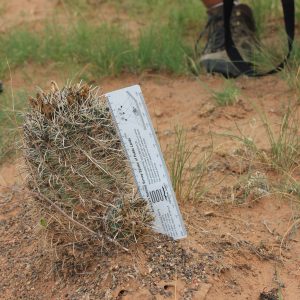Dustin Rooks, a blonde-haired man in his mid-thirties whose fair skin is painted tan from numerous rendezvous with the sun, greeted me with a wide smile and said, “Boy, did you pick a terrible year to pick seeds, but that’s alright because we have bigger issues — cactus.” I am, in fact, not a boy; having grown up in Colorado with family in the rural midwest, however, I am used to the antiquated country jargon. Dustin is the state botanist for Utah’s Bureau of Land management, and with his laid-back demeanor, one can tell he loves his job. My first day as an intern he takes me to the offices of the other employees at the Richfield BLM. The office is pseudo-divided by cubicles created by the idealists in an attempt to keep people honest; no privacy — no room for shenanigans, as reiterated by the numerous phone conversations heard from afar. Ending where we began, I meet the office manager and was immediately briefed on Central Utah’s cactus dilemma.
In 1979, Sclerocactus wrightiae, also known as Wright’s fishhook cactus, was added to the endangered species list. S. wrightiae is endemic to Utah, thriving in sandy-textured soil — meaning its sole habitat of choice happens to be the badlands of Utah. When listed, the BLM knew they were going to be walking a fine line balancing the necessary monitoring of S. wrightiae populations and upholding their mission to keep the lands open for multi-use. You see, another species that also prefers the badlands is the dirt-biking breed of Homo sapiens. Mentioning Wright’s fishhook cactus to a member of this gloriously dignified group brings a similar reaction as telling a teenager he or she can’t go the party. Anger. Rage. Best of all — rebellion.
Being an endangered species there are certain regulations that must be met, including (but not limited to) closing off areas where Wright’s fishhook cactus is found. This is unwelcoming news for enthusiasts that have been getting down-and-dirty riding on these grounds for decades. As of now, Dustin is the one who is trying to protect the survival of Wright’s fishhook while ensuring BLM’s public lands remain just that, public. Compliancy is good news for both Dustin and the off-highway vehicle (OHV) community. With continued trend of compliancy and growing survival rates for S. wrightiae, the day is approaching where the OHV fanatic can once again hop on their gold chariot and ride into the sun.
- Allison and Dustin taking measurements of one of the largest Wright’s fishhook cactuses we’ve found.


